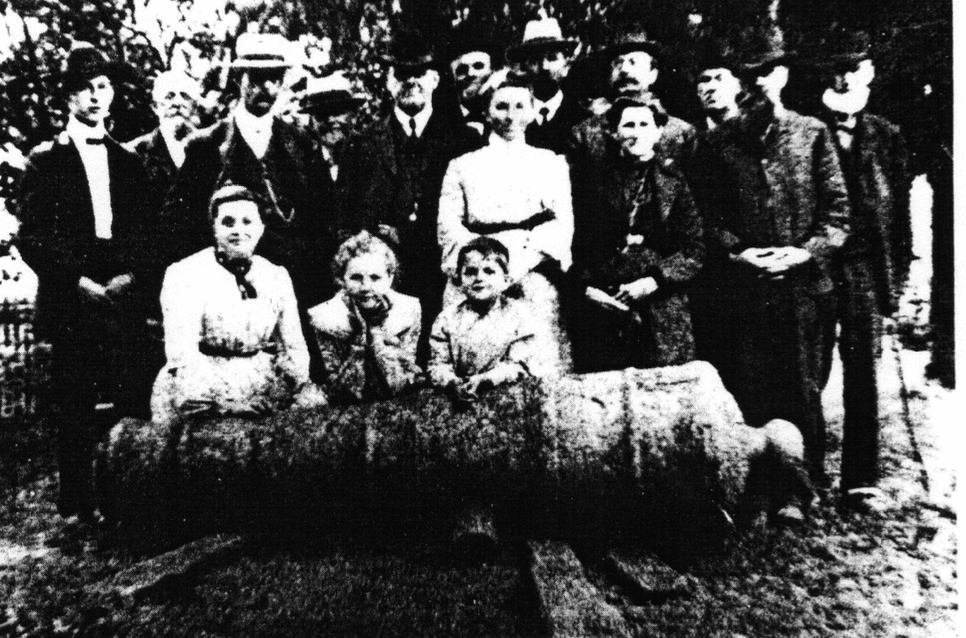Crow’s Nest: Everything old is new again
By Daniel Barringer, Preserve Manager.

Photo supplied by Robert Earl Houck
You may have read about four Revolutionary War cannons that were found recently on a preserve nearby that is managed by our friends at a local conservation organization, the French & Pickering Creeks Conservation Trust. The Thomas P. Bentley Preserve is just minutes away from Crow’s Nest and includes the site of the historic Warwick Furnace.
But this is not the first time historic cannons were found near there. This year as I’ve found free time I’ve been scanning articles about the history of the Crow’s Nest Preserve neighborhood, written by local resident Robert Earl Houck (1918 – 2004) who grew up in a farmhouse located on what is now Crow’s Nest. The information he shared has helped us understand the last century’s land-use history as well as the way of life for people living here 100 years ago—far different from today. The region where we live and work has been continuously occupied by people for 14,000 years and we still have a lot to learn about how this has impacted the landscape; having an informant tell us about the most recent portion of that history is valuable.
Robert Earl Houck shared the story of how a cannon was found in 1903 in the south branch of French Creek next to which Warwick Furnace had been built in 1737-38. The furnace was built by Anna Nutt & Co.; she is considered the first woman industrialist in what is now the United States. (I am relying here on the scholarship of historian Daniel Graham, quoted in a newspaper article and on the website of Warwick Furnace Farm.) The most recent article about the newly-discovered cannons is in the July 20, 2022 edition of the Morgantown/Honey Brook Community Courier: “Unearthing History” by Francine Fulton (page 1).
Warwick Furnace was built beside the creek because a water wheel turned by water in a millrace powered the bellows that provided oxygen for the process that converts iron ore, charcoal, and limestone to make iron. While the furnace at Warwick is an imposing ruin today, you can see what a working one looked like if you visit Hopewell Furnace National Historic Site, adjacent to Crow’s Nest. This was once iron country, chosen for streams suitable for water power, iron ore in the ground, and plentiful forests to be made into charcoal. This industrial use of the landscape may be difficult to visualize in the forests of today, but this history has definitely affected which species dominate now.
Let’s pick up Robert Earl Houck’s story here, as told to him by Leon Spohn, son of Amos Spohn:
During the month of August 1903, Amos Spohn and his two Brothers, Joseph and George H. were gigging for eels in the South Branch of the French Creek, near the corner Warwick Furnace located in Warwick Twp. He said “I saw a big sucker and I plunged forward to spear the fish, but I missed and the spear hit something hard and sounded hollow in the sand and mud in the stream. I checked to see what was under the spear and found a Revolutionary Cannon which had been hidden along the bank by the workmen of the Furnace [from] the British, should there be a retreat from the Brndywine area in Sept. 1777. We went home and told our parents about it, and my Mother wrote to Mr. Kaufman telling him what her boys had found.” At this time the Spoon family lived on one of his tenant houses.
A few days later Mr. Kaufman came to the farm with his hired man, also a hay wagon pulled by eight mules. They tried to pull it loose, but needed more power, so they went to the stable and got two more mules. They finally loaded it on the wagon and took it to his home located in the Oley Valley. The National Park Service verified that it was made at Warwick Furnace. Mr. Ephrain Kaufman was the owner of Warwick Furnace Farm at that time but lived near Oley. He was a Banker in Reading Pa.
Notably, the recently-excavated cannons also required more power than was initially available to get them out of the ground. But instead of being discovered by serendipity, this time people were searching for them using sensitive equipment and remotely piloted drones.
We know some things about our history and other things we still seek to know. We try to tell these stories as we lead tours in order to show their influence on today’s forest and offer an example of how resilient nature can be.
A neighbor recently donated four cannonballs that had been found in the woods here before the land became Crow’s Nest Preserve (which is now 31 years old). We don’t think they were buried here to keep them out of British hands—as the cannons had been—but may have been considered scrap metal offloaded from a train that used to pass here in the late 1800’s and early 1900’s. Again according to Robert Earl Houck, scrap metal was unloaded into three-sided stone huts beside Mine Run, the roof and fourth side (pointing toward the side of Fox Hill, the ridge that runs through our Deep Woods) covered with logs, then the metal was blasted apart with dynamite. Little sign of this past industrial land use exists today in the lush forests here.
